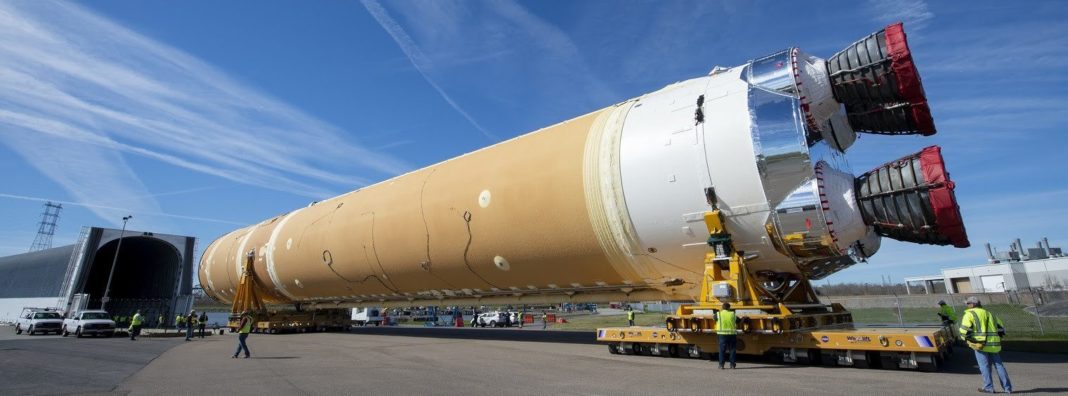
The moon, I think, misses us. Of the twelve human beings who have ever walked on its surface, eight have now passed away. Not a soul has been there since 1972.
Since the end of the Apollo program, no astronaut has gone beyond low-Earth orbit (LEO). Except for a small number of unmanned probes, we have stayed close to home. Thankfully, this may soon change. The White House and NASA want to return to the moon by 2024 through the Artemis program. Elon Musk wants to put a city on Mars with a million people by 2050. The era of human space colonization is beginning.
This ambition presents a technical challenge. If we want to colonize the moon, Mars, and beyond, we need a way to get humans and many tons of cargo to those places. We don’t have a rocket powerful enough to deliver that kind of payload anymore. Saturn V, the rocket that powered the Apollo moon landings, retired from service in 1973. It could transport up to 140 metric tons to LEO, the most of any rocket ever. From LEO, to escape from Earth’s gravity well on its way to the moon, Saturn V needed to burn more fuel, limiting payload to the moon to 48.6 tons of people and cargo.
Diagram from Wikimedia Commons.
Trying to colonize the moon 48.6 tons at a time may itself be challenging, but Saturn V isn’t even around anymore. Today’s rockets carry much more modest payloads. They were designed to transport humans to the International Space Station orbiting only 254 miles above the Earth, or to take payloads as big as the 7-ton TerreStar-1, the biggest satellite ever launched, to geostationary orbit (GEO), 22,236 miles above the equator. The latest and greatest Block-5 Falcon 9 rocket from SpaceX, the most popular commercial launch vehicle in recent years, can take only 22.8 tons to LEO in an expendable configuration (i.e., if SpaceX isn’t trying to recover the booster).
If we are going to colonize space, the world is going to need a bigger rocket.
The Space Launch System
The Space Launch System (SLS) is the federal government’s latest effort to build a super heavy-lift launch vehicle capable of delivering large payloads to space. The program, which contractors are now developing for NASA, began as a way to salvage engineering and jobs from two other canceled programs. One, the Constellation Program, began in 2005 to develop rockets and crew capsules suitable for completing construction of the International Space Station, returning humans to the moon, and going to Mars. NASA doled the program out to traditional space and defense contractors like Boeing and Lockheed Martin.
When President Obama entered office in 2009, his administration found that the Constellation Program had incurred enormous cost overruns. It would take $150 billion to keep the program on track. Because of the high price tag and the lack of innovation — Constellation, after all, did not feature novel technologies like reusability or on-orbit refueling — the Obama administration canceled the program in its 2011 budget request.
2011 also marked the end of the Space Shuttle program, which was already 15 years beyond its planned life. The cancellation of these two programs brought demand for a new program to absorb the newly unemployed engineers. Senators from Alabama, Texas, and Florida pushed to create the Space Launch System using engineering and parts from Constellation and the Space Shuttle. This ensured that jobs in those states could stay there for another decade or more.
The SLS is a big vehicle. The initial version, reusing engines from the Space Shuttle program, will be capable of carrying 95 tons to LEO and 26 tons to the moon. A planned upgraded Block-2 variant would take up to 130 tons to LEO.
Components of the Space Launch System
Diagram by NASA.
Big rockets are nice, but the SLS program was always unmoored from any practical space exploration goal. At the time Congress appropriated funds for SLS, there was no moon mission to design for. The Artemis program did not exist until 2017. SLS was a rocket to nowhere. Author Rand Simberg saw it clearly in 2011: “Ultimately, jobs — and not actual progress in space — seem to be the driving force of the program. Even if it never actually flies, SLS may still meet its primary misson requirement: delivering federal funding to the states and districts of those in Congress in with a particular interest in NASA’s budget.” Even today, many of SLS’s supporters defend it as a jobs program.
The Obama administration reluctantly agreed with Congress to fund the SLS program in exchange for support for the commercial crew program that would send US astronauts to the International Space Station on Boeing and SpaceX capsules as soon as this year. Boeing won the core stage SLS contract based on its prior contract for Constellation. If all went as planned, SLS’s first launch would be for Exploration Mission-1 (EM-1), an uncrewed mission around the moon, in December 2017.
All did not go as planned. The launch date for EM-1, which eventually became Artemis 1, moved from December 2017 to July 2018 to November 2018 to December 2019 to June 2020. In November 2018, less than a year after moving the launch date to June 2020, NASA acknowledged that the revised date is unlikely. According to a Government Accountability Office report, the date could now be as late as June 2021.
Throughout this period of delays, the cost of the SLS went up. In 2018, a NASA Inspector General (IG) report projected that the core stage cost would balloon to at least $8.9 billion through 2021. That is more than double the $4.2 billion projected when the contract was finalized in June 2014. This cost overrun was no problem for Boeing, however, because NASA issued the contract on a cost-plus basis. As costs go up, so do payments to the company.
The IG also found that despite multi-year delays in the SLS schedule and ballooning costs, NASA paid Boeing millions of dollars in award fees, which the agency grants based on performance. NASA contract managers subjectively rated Boeing performance as very good to excellent every year from FY2013 to FY2017. This made the company eligible for $234 million in award fees out of a possible total of $262 million.
Source: NASA Office of Inspector General.
A few months after the IG report, GAO found that NASA had obscured a further $782 million in cost growth on the SLS program by moving some cost projections onto future Artemis missions without adjusting the baseline comparison.
This obscuration raises the point that costs on complex NASA programs are quite opaque. The sleuths at Wikipedia estimate that SLS funding is actually around $14 billion in spent and appropriated funds from 2011 to 2018, including upper stages. They are quick to add that this does not include Ares V or Ares I funding done under the Constellation (from which the SLS is derived), the Orion capsule (which is SLS’s main payload), or the integration costs for SLS or Orion.
So the SLS program was ill-conceived from its inception, inept in its execution, way over budget, and way behind schedule.At least we’ll get a lot of use out of it once it’s done, right? Wrong. Despite SLS’s impressive payload capabilities, its launch economics are terrible. Launch costs for non-commercial programs are opaque, but we can get a glimpse into SLS’s costs via a letter from the Office of Management and Budget to the Senate Appropriations Committee. Regarding NASA’s Europa mission, which is currently required by Congress to use the SLS, OMB urges the Committee to consider using a commercial launch provider instead. “At an estimated cost of over $2 billion per launch for the SLS once development is complete, the use of a commercial launch vehicle would provide over $1.5 billion in cost savings,” wrote OMB.
That $2 billion figure appears to include around a $900 million marginal cost of the rocket plus the facilities needed to produce more than one rocket per year, as the Europa mission would require. As OMB emphasizes, this estimate excludes all development costs. Including development costs, the cost per launch could be $4–5 billion.
Despite enormous costs and schedule problems, SLS still retains its supporters in Congress. “While I agree that the delay in the SLS launch schedule is unacceptable, I firmly believe that SLS should launch the Orion,” said Alabama Senator Richard Shelby, Chairman of the Appropriations Committee. Alabama is home to NASA’s Marshall Space Flight Center, which hosts development of large parts of the SLS. In its 2020 budget request, the Trump administration did not request funds for future blocks of the SLS or for the SLS’s Exploration Upper Stage, but Congress included it anyway, while mandating use of SLS for the Europa mission. This week’s draft NASA authorization bill would be another giveaway to Boeing.
Private super heavy lift vehicles are coming
From humble beginnings, the private space industry has made enormous progress. SpaceX has captured around 65 percent of the commercial launch market with the partially-reusable Falcon 9. On a reflown booster, the list price of a Falcon 9 launch is only $50 million and continues to fall as boosters are reflown more often. Launch on the three-booster Falcon Heavy has a list price of $90 million. As Blue Origin completes its partially reusable orbital New Glenn rocket next year, competition should heat up. New Glenn will take a payload of up to 45 tons to LEO, placing it closer to Falcon Heavy in payload than to Falcon 9 — and with much more payload volume.
This is exciting competition, but a step change will occur with SpaceX’s Starship, due to start carrying commercial payloads next year. It will lift 150 tons to LEO on SpaceX’s Super Heavy booster. Unlike Falcon 9, Falcon Heavy, or New Glenn, Starship will be fully reusable — both the Super Heavy booster and the second-stage Starship vehicle itself can land and fly again.
Unlike the SLS, Starship will be capable of on-orbit refueling, meaning it doesn’t have to reduce payload size to reach higher orbit. A fully laden Starship with a 150-ton payload will be able to launch to LEO, dock with another Starship full of fuel, and get refilled. With a full tank of gas starting in LEO, the first Starship would then be able to take its 150-ton payload anywhere in the solar system.
On-orbit refueling gives Starship an enormous performance advantage. Even the most powerful Block 2 version of the SLS, not due to be complete before the 2030s, will only be able to carry 45 tons to the moon. If Starship succeeds, it will have more than three times the lift capability to the moon as the most powerful version of the SLS, all without costing taxpayers anything in development funds.
Full reusability gives Starship an enormous economic advantage over SLS. Whereas the marginal cost of an SLS launch is at least $900 million (but probably much more), SpaceX says Starship launch prices should be much lower. Maybe unbelievably low.
Starship render by SpaceX.
On Twitter, SpaceX CEO Elon Musk has said he thinks there is a path to manufacture Starship and Super Heavy for less than the cost of Falcon 9. Using liquid methane as fuel instead of conventional RP-1 would reduce fuel costs to only $900,000 per launch. Finally, reusability is a game-changer for lowering costs. All told, Musk expects the price of a Starship launch to LEO to be less than a tenth as much on a per-kilogram basis as a Falcon 9.
Let’s do the math on that. Assuming a reusable Falcon 9 configuration and the $62 million list price for a launch of a new booster, that amounts to $3690/kg. To reach $369/kg on a 150-ton payload, a launch would have to cost around $55 million. Even assuming you have to launch two Starships to take advantage of on-orbit refueling, that amounts to a cost of $110 million to take 150 tons of cargo to the moon. This $110 million price tag is less than an eighth of the cost of an SLS launch, while transporting a payload of three times as much mass, a 24-fold improvement in launch efficiency.
Economically obsolete before first flight
NASA deserves enormous credit for supporting the development of the private space industry. They have provided technical expertise and a paying customer to rocket startups including SpaceX. Thanks to that support and private investment in launch capabilities, we are on the cusp of a new era in human space exploration. Due to reusability, on-orbit refueling, and economies of scale enabled by lower-cost, permanent human settlements on the moon and Mars are now within reach. That’s why it’s so frustrating that NASA’s budget is being used by Congress to supply a handful of states with cushy jobs at legacy defense contractors on cost-plus contracts.
NASA’s human spaceflight programs are headed to an absurd outcome: Congress will force the agency to pay $2 billion per launch on the SLS while New Space companies like SpaceX and Blue Origin — companies that NASA helped foster — offer the same capabilities for a tenth of the cost or less. It’s an enormous waste of taxpayer funds. Ultimately, it means we get much less development of space for our money. Instead of a lunar gateway, we could have a city on the moon.
SLS Block 1 is almost done, but it is already economically obsolete. In a sane world, Congress would shut down the entire program and NASA’s space exploration would proceed using commercial rockets. Alas, that is not the world we live in.
Fortunately, the private sector is moving forward without NASA’s billions. In a few short years, humans will once again walk on the moon. And then they will go to Mars. Humanity will soon have cities in space. And when the history of this era is written, the record will show that the colonization of space happened despite an extraordinary waste of government funds on a rocket that nobody wanted to use.


 AVweb
AVweb